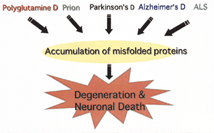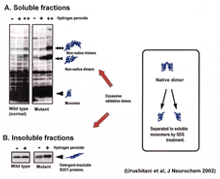 |

magnified
scene by clicking image
|
The primary research focuses
of our lab are the etiology and development of treatments for amyotrophic lateral
sclerosis (ALS) and Parkinson's disease. With ALS, the motor nerve cells degenerate,
hindering muscle control, eventually causing death. In a few years, the body's
voluntary movement including respiration (i.e. the respiratory system) start to
breakdown, which limits the patient's freedom to move and breathe with the use
of machines and supports. As the patient's dire situation compels physcians to
do something for this disease. Parkinson's disease also impairs motor function;
however, in this case, neurons called dopaminergic neurons which act on the central
control of motion die causing motion to slow and frequent falling and stumbling.
As the disease progress, the patient is bedridden. Parkinson's disease is relatively
common disease, occurring in more than 1% of persons over 65. As developed societies
age, this disease will be a more grave concern. In general, ALS and Parkinson's
disease are non-hereditary, neurodegenerative diseases. Older textbooks use "neurodegenerative
diseases" as a generic term for diseases that have unknown causes, gradually develop
and progress with aging, and pathologically cause degenerative loss of neurons
or fibers in the nervous system (partial modification of the definition by Dr.
Nobuo Yanagisawa). In short, these are strange, intractable diseases. Twenty years
ago when I was senior medical student, I saw a video during a neurology lecture
of a patient with a hereditary neurodegenerative disease, Huntington's disease.
This disease is also called Huntington's chorea and one of its main symptoms is
that the hands and feet move involuntarily as if they are dancing. After the lecture
a friend, who later became an excellent surgeon, asked me, "Do you think such
an intractable disease will ever be cured?" Knowing that I wanted to be a neurologist,
I wistfully predicted, "The causes of neurodegenerative diseases will surely be
elucidated and treatment methods will be developed." Looking back at the splendid
research on neurodegenerative diseases over the last 20 years, my hunch was not
far off. Rapid progress in research has been possible because of advanced in genetics;
and, even though the causes of neurodegenerative diseases are still unknown, it
is clear that the causes of hereditary diseases are genetic. When I graduated
from college, the locus of Huntington's disease was determined, and since then
most of the causative genes of major hereditary neurodegenerative diseases have
been identified. Functional analyses of etiological genes based on these results
followed, leading to two important discoveries. One was the discovery that many
hereditary neurodegenerative diseases develop from the accumulation of abnormal
proteins caused by gene mutations (Fig. 1).

magnified
scene by clicking image

magnified
scene by clicking image
|
Accurate protein folding
is essential to permit them to function normally. Therefore, misfolded proteins
do not function properly, adhere to one another, agglutinate, precipitate inside
and outside the cells, and exhibit cytotoxicity. Another discovery was that the
gene products (proteins) causing hereditary diseases often cause similar non-hereditary
diseases, too. Parkinson's disease is a good example.  -synuclein
was first identified as the etiologic gene causing autosomal-dominant hereditary
Parkinson's disease, which is very rare-occurring in only a few families in the
world. And yet identification of the gene in this disease has greatly benefited
research on the more common, non-hereditary Parkinson's disease. After identifying
the gene, the main component of an abnormal aggregate in the neuron, the Lewy
body (which pathologically characterizes Parkinson's disease) was confirmed to
be -synuclein
was first identified as the etiologic gene causing autosomal-dominant hereditary
Parkinson's disease, which is very rare-occurring in only a few families in the
world. And yet identification of the gene in this disease has greatly benefited
research on the more common, non-hereditary Parkinson's disease. After identifying
the gene, the main component of an abnormal aggregate in the neuron, the Lewy
body (which pathologically characterizes Parkinson's disease) was confirmed to
be  -synuclein. It is now widely accepted
that -synuclein. It is now widely accepted
that  -synuclein, the protein misfolded
by hereditary or acquired factors, causes Parkinson's disease by exhibiting neurotoxicity.
Our team is focusing on two proteins, mutant SOD1 (which is the etiology of autosomal-dominant
hereditary ALS) and Parkin (which is deficient in autosomal-recessive hereditary
Parkinson's disease (AR-JP)). So far, we have confirmed that mutant SOD1 exhibits
the characteristics of a misfolded protein and these characteristics
worsen with oxidative stress (Fig. 2). We have also discovered that Parkin is
the enzyme participating in proteolysis and believe that the misfolded protein,
Pael receptor, accumulates due to lack of Parkin, causing AR-JP (Fig. 3). Since
the Pael receptor may participate in the etiology of non-hereditary Parkinson's
disease by locating downstream the signal for neuronal death caused by -synuclein, the protein misfolded
by hereditary or acquired factors, causes Parkinson's disease by exhibiting neurotoxicity.
Our team is focusing on two proteins, mutant SOD1 (which is the etiology of autosomal-dominant
hereditary ALS) and Parkin (which is deficient in autosomal-recessive hereditary
Parkinson's disease (AR-JP)). So far, we have confirmed that mutant SOD1 exhibits
the characteristics of a misfolded protein and these characteristics
worsen with oxidative stress (Fig. 2). We have also discovered that Parkin is
the enzyme participating in proteolysis and believe that the misfolded protein,
Pael receptor, accumulates due to lack of Parkin, causing AR-JP (Fig. 3). Since
the Pael receptor may participate in the etiology of non-hereditary Parkinson's
disease by locating downstream the signal for neuronal death caused by  -synuclein,
we are trying to clarify the route. We are also working to find the pathologic
signals related to neurodegeneration. We have succeeded in isolating a new inducer
for neuronal death named HtrA2 and are investigating its involvement in specific
deseases. We will continue with this research to develop treatments for ALS and
Parkinson's disease as soon as possible. Six years ago the accumulation of polyglutamine,
a misfolded protein was identified as the cause of Huntington's disease. And recent
studies using animal models have demonstrated the effects of this disease are
alleviated by a molecule chaperone, a transcriptional factor, inhibition of apoptosis,
etc. Something believed impossible by my classmate more than 20 years ago, the
treatment of neurodegenerative diseases, is no longer a dream. Our team is striving
to develop real treatments. -synuclein,
we are trying to clarify the route. We are also working to find the pathologic
signals related to neurodegeneration. We have succeeded in isolating a new inducer
for neuronal death named HtrA2 and are investigating its involvement in specific
deseases. We will continue with this research to develop treatments for ALS and
Parkinson's disease as soon as possible. Six years ago the accumulation of polyglutamine,
a misfolded protein was identified as the cause of Huntington's disease. And recent
studies using animal models have demonstrated the effects of this disease are
alleviated by a molecule chaperone, a transcriptional factor, inhibition of apoptosis,
etc. Something believed impossible by my classmate more than 20 years ago, the
treatment of neurodegenerative diseases, is no longer a dream. Our team is striving
to develop real treatments. |
 |
 |
|
 |
|
|






